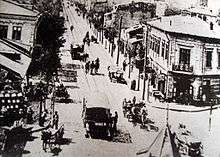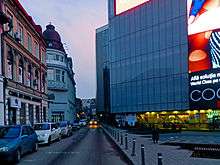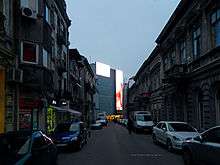Calea Moșilor




Calea Moșilor (Romanian pronunciation: [ˈkale̯a ˈmoʃilor]) is both a historic street and a major road in Bucharest, Romania. It runs from the back of the Cocor Shopping Mall (near Piața Unirii) to Obor. The street is divided into two distinct parts. East of the intersection with Carol I Boulevard the street has two lanes and consists of apartment blocks built during the communist era, while West of the intersection with Carol I Boulevard the street has only one lane and consists of houses build in the 19th century.[1]
History
The old name of Calea Moșilor is Podul Târgului din Afară which translated means The Bridge of Outside Fair (also market or even field), referring to a big fair held outside the city. Why "the Bridge" (Romanian: pod)? Probably because all main roads in medieval Bucharest were "paved" with wood and had a resemblance to a bridge. In any case, pod was a common name for a major road in Romania into the 19th Century. For example, Calea Victoriei was once known as Podul Mogoșoaiei. Most of main roads were Prince's Roads (alternatively "Princely Roads", Podurile Domnesti) and they usually began from the nearby Curtea Veche (Old Princely Court). Podul Târgului din Afară was in fact one of the major streets of medieval Bucharest.
It was a Prince's road that had its beginning at St. Anton square/market, close to Curtea Veche. The street was much shorter in the past, the city limits being just somewhere at Saints' Church (Biserica Sfinţilor) towards the northeast, at junction with Strada Sfinţilor. This was the first known location of the Outside Market. Later, the city expanded and city limits were moved towards Oborul Vechi Church and Fire Watchtower (Foisorul de Foc). Because it was meant to be an out of city market, these new limits became the next location of Târgul de Afară. The city limits were eventually moved farther, and the road extended with it. Now Târgul de Afară found its destination in the place which is now known as Obor Market Piaţa Obor. Târgul de Afară became Târgul Moșilor, famous Fair throughout Wallachia held twice a week and it was direct precursor of Obor Market. From here on heading towards North-East, the road was making connection to cities from Moldova, but also cities like Brăila, Galaţi or Lvov.

The street itself was filled on both sides by small shops, tradesmen workshops, taverns, porter houses, small inns, churches, and more.
The end of Podul Târgului de Afară near Piaţa Obor was also the place where convicted people were executed by hanging. This is The place where famous bandit Iancu Jianu was supposed to be executed for his outlaw activity but one of noble ladies of the Court, Sultana Gălăşescu, saved him from death penalty by taking him as a husband. They had two children afterwards.
Calea Moșilor was the first street paved with cobblestones in Romania in 1825.[2] Slowly all the streets in Bucharest and Romania took the same turn and wooden "bridges" were forgotten for good.
Between 1978 and 1982 the old historic streets between Carol I Boulevard and Obor were demolished and replaced with 8 to 10 stories tall apartment blocks, and the road was widened from 2 lanes to 4 lanes with integrated tram tracks. In 1987 a trolleybus line was added. Nowadays the area has seen redevelopment and refurbishing of older apartments. The old Calea Moșilor between Carol I Boulevard and Unirii Square has been kept the same, but over the years some of the houses have been abandoned and dilapidated.
Transportation
RATB tram line 21 runs along the street, and trolleybus 66 runs until Bulevardul Carol I where it joins the other trolleybus lines towards Universitate.
References
External links
| Wikimedia Commons has media related to Calea Moșilor. |
Coordinates: 44°26′34″N 26°07′07″E / 44.442666°N 26.118643°E

